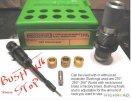Local JW. You can use either a FL die without a bushing or a FL die with a bushing small enough to reduce the necks a sufficient amount. A FL die without a bushing tends to reduce necks more than necessary at around 0.005-0.010" -- you can measure this for your dies and cases by measuring the neck OD and ID of your fired cases after you size a case in the die without the expander. In a FL die with a bushing, you need to just select the correct sized bushing to give adequate neck size reduction. I agree with "Huntnful," typically about 0.004" under loaded neck diameter. By using a FL bushing die and selecting a bushing size to not size the case as much as a non-bushing die, you will work the cases less and provide less work-hardening of the brass.
It may sound complicated, but it is much easier than it sounds once you have the parts and just experiment and take your measurements along the way. I was overwhelmed with all the info available about 18 months ago too. I didn't know what to buy and didn't want to make a mistake. However, I spoke to the staff at K&M, took their advice, and just dove in. (See my post immediately above for an example from K&M that may help clarify the sizes and relationships between bushings and mandrels and neck tension calculations.)
This thread is a wealth of good and reliable information by a bunch of shooters that know what they are talking about. If you select the suggested bushings and mandrels, you will be in a good safe zone. From there, you can experiment.
I personally use both FL non-bushing dies and FL bushing dies -- good quality, but whichever I have on hand.
Real examples that I hope will make it clearer:
1. .270 Weather Mag: (STARTING WITH FIRED CASES WITH NON-BUSHING DIE)
- Weatherby .270 Wby FL non-bushing die
- Weatherby cases with neck wall thickness approximately 0.014" per side
- Expander ball from die: 0.27495" (measured)
- Expander mandrel chosen to be similar to expander ball diameter, and to provide approximately 0.003" NT:
- 0.275" mandrel selected
(Mandrel at 0.002" under bullet diameter with 0.001" brass spring back should provide 0.003" NT)
- 0.275" mandrel measured: 0.27515"
- Fired unsized cases: neck OD: 0.3075, ID: 0.2775
- Fired cases sized in Wby FL die WITHOUT expander: neck OD: 0.2975, ID: 0.2695
- These necks were reduced 0.008" by the non-bushing FL die (0.2775 - 0.2695)
- Fired and sized cases with necks expanded with 0.27515" expander: neck OD: 0.2995, ID: 0.2735
- These necks were expanded by 0.004" with the mandrel (0.2735 - 0.2695)
- Final Neck Tension = (bullet diameter) - (final neck ID) = (0.277) - (0.2735) = 0.0035"
- Case Neck total indicator runout after case prep and before bullet seating: 0.0005 - 0.0009"
- Accuracy: ⅝" for 3 shots at 100 yds (Weatherby Mark V)
2. 6 mm Creedmoor (STARTING WITH NEW CASES WITH BUSHING DIE)
- Whidden Competition FL bushing die
- Expander ball measured at: 0.24100"
- Lapua 6mm CM cases with neck wall thickness approximately 0.0145"
- Cases necks turned to 0.0140" to clean up high spots only
- Calculated loaded neck OD = (0.014)2 + 0.243 = 0.2710"
- Measured neck OD with 0.243 bullet in neck: 0.2710" (same as calculated)
- Select bushing 0.005" below loaded OD, therefore Bushing size: 0.2710 - 0.005 = 0.266"
- FL sized cases with 0.266" bushing (without expander ball): neck OD: .2675, ID: 0.2372
- Necks reduced by 0.0035" less than loaded round (0.2710 - 0.2675)
- Select mandrel similar to expander ball (0.24100) to give approximately 0.002 - 0.003" NT
(Expander mandrel 0.002"under bullet diameter + 0.001" spring back should give approximate desired NT)
- Expander mandrel measured at: 0.2410
- Expand with 0.2410 mandrel: neck OD: 0.2694, ID: 0.2392
- Necks were expanded by 0.0020" (0.2392 - 0.2372)
- Final Neck Tension = (bullet diameter) - (final neck ID) = (0.243) - (0.2392) = 0.0038"
- AVERAGE Case Neck Total Indicator Run-Out for 5 cases after case prep and before bullet seating:
- New Cases: 0.0007"
- New cases after sizing with bushing die: 0.0005"
- New cases after sizing and then expanding with mandrel: 0.00046
- Accuracy: ⅜" for 5 shots @ 100 yds (Ruger RPR)
From my personal experience, after working with several rifles and cartridges, and both and fired cases, I have found the following general guidelines helpful in selecting bushings and mandrels sizes when using a bushing to reduce the neck sufficiently to allow an expander to set your final neck tension reliably:
1. When you size necks down in a die or with a bushing, the neck diameter will spring back up approximately 0.001" larger than the bushing ( ie. using a 0.266 bushing to reduce the neck, then neck will often spring back to 0.267").
2. When you expand case necks with a mandrel, the neck will often spring back down approximately 0.001" (ie. using a 0.241 mandrel to expand the neck, the ID will often spring back to 0.240").
3. The amount of spring back in both directions is only an estimate, and is effected by brass quality, neck size, number of case firings, annealing, work hardening, and other factors.
4. Bushing Sizes:
- Minimum: 0.004" under loaded neck OD if case necks are turned or < 0.014" thick
- Typical: 0.005" under loaded neck OD if case necks are not turned or > 0.014" thick
5. Mandrel Sizes:
- Minimum: 0.001" under bullet diameter (should produce approximately 0.002" neck tension with spring back)
- Typical: 0.002" under bullet diameter (should produce approximately 0.003" neck tension with spring back)
Good luck.

